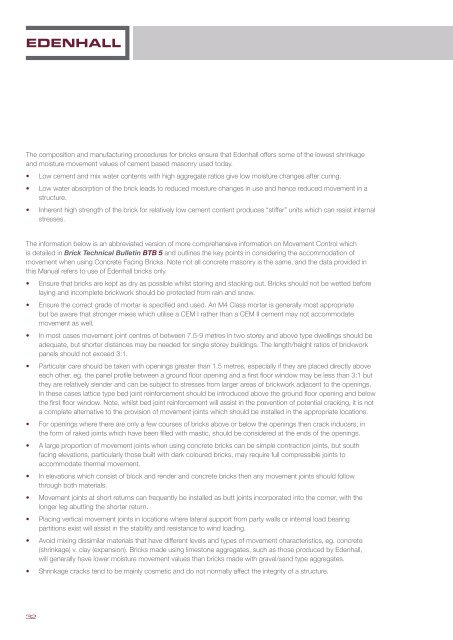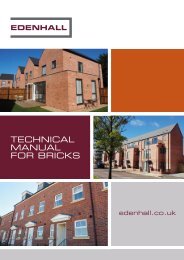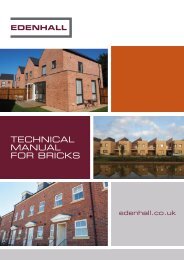You also want an ePaper? Increase the reach of your titles
YUMPU automatically turns print PDFs into web optimized ePapers that Google loves.
The composition and manufacturing procedures for bricks ensure that <strong>Edenhall</strong> offers some of the lowest shrinkage<br />
and moisture movement values of cement based masonry used today.<br />
• Low cement and mix water contents with high aggregate ratios give low moisture changes after curing.<br />
• Low water absorption of the brick leads to reduced moisture changes in use and hence reduced movement in a<br />
structure.<br />
• Inherent high strength of the brick for relatively low cement content produces “stiffer” units which can resist internal<br />
stresses.<br />
The information below is an abbreviated version of more comprehensive information on Movement Control which<br />
is detailed in Brick <strong>Technical</strong> Bulletin BTB 5 and outlines the key points in considering the accommodation of<br />
movement when using Concrete Facing Bricks. Note not all concrete masonry is the same, and the data provided in<br />
this <strong>Manual</strong> refers to use of <strong>Edenhall</strong> bricks only.<br />
• Ensure that bricks are kept as dry as possible whilst storing and stacking out. Bricks should not be wetted before<br />
laying and incomplete brickwork should be protected from rain and snow.<br />
• Ensure the correct grade of mortar is specified and used. An M4 Class mortar is generally most appropriate<br />
but be aware that stronger mixes which utilise a CEM I rather than a CEM II cement may not accommodate<br />
movement as well.<br />
• In most cases movement joint centres of between 7.5-9 metres in two storey and above type dwellings should be<br />
adequate, but shorter distances may be needed for single storey buildings. The length/height ratios of brickwork<br />
panels should not exceed 3:1.<br />
• Particular care should be taken with openings greater than 1.5 metres, especially if they are placed directly above<br />
each other, eg. the panel profile between a ground floor opening and a first floor window may be less than 3:1 but<br />
they are relatively slender and can be subject to stresses from larger areas of brickwork adjacent to the openings.<br />
In these cases lattice type bed joint reinforcement should be introduced above the ground floor opening and below<br />
the first floor window. Note, whilst bed joint reinforcement will assist in the prevention of potential cracking, it is not<br />
a complete alternative to the provision of movement joints which should be installed in the appropriate locations.<br />
• For openings where there are only a few courses of bricks above or below the openings then crack inducers, in<br />
the form of raked joints which have been filled with mastic, should be considered at the ends of the openings.<br />
• A large proportion of movement joints when using concrete bricks can be simple contraction joints, but south<br />
facing elevations, particularly those built with dark coloured bricks, may require full compressible joints to<br />
accommodate thermal movement.<br />
• In elevations which consist of block and render and concrete bricks then any movement joints should follow<br />
through both materials.<br />
• Movement joints at short returns can frequently be installed as butt joints incorporated into the corner, with the<br />
longer leg abutting the shorter return.<br />
• Placing vertical movement joints in locations where lateral support from party walls or internal load bearing<br />
partitions exist will assist in the stability and resistance to wind loading.<br />
• Avoid mixing dissimilar materials that have different levels and types of movement characteristics, eg. concrete<br />
(shrinkage) v. clay (expansion). Bricks made using limestone aggregates, such as those produced by <strong>Edenhall</strong>,<br />
will generally have lower moisture movement values than bricks made with gravel/sand type aggregates.<br />
• Shrinkage cracks tend to be mainly cosmetic and do not normally affect the integrity of a structure.<br />
32







